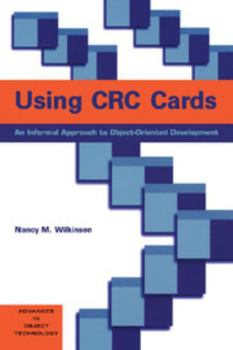Using CRC Cards: An Informal Approach to Object-Oriented Development
Select Format
Select Condition 
Book Overview
Using CRC Cards, first published in 1995, is a comprehensive introduction to CRC (Class, Responsibility, Collaborator) cards. It includes a description of the cards and how they can be used in... This description may be from another edition of this product.
Format:Paperback
Language:English
ISBN:0133746798
ISBN13:9780133746792
Release Date:January 1998
Publisher:Sigs
Length:250 Pages
Weight:0.05 lbs.
Dimensions:0.7" x 7.0" x 9.0"
Related Subjects
Computer Science Computers Computers & Technology Education & Reference Languages & Tools Mathematics Methodology Object-Oriented Design Object-Oriented Software Design Programming Programming Languages Science & Math Software Software Design & Engineering Software Design, Testing & Engineering Software Development Software EngineeringCustomer Reviews
2 ratings
CRC cards can be used to advantage and Wilkinson demonstrates how to do it
Published by Thriftbooks.com User , 15 years ago
Class, Responsibility, Collaborator (CRC) cards are one of the least technical tools that can be used in software creation. Quite literally, a five-year-old can use them. For they are nothing more than index cards that the members of the design team use to write their notes on the classes, class methods and the relationships between them. Their simple structure and small size mean that they can only be used to sketch the general details of the design. This is an enormous advantage in the initial stages, because it forces the members of the team to maintain a "view from a height." One of the easiest mistakes to make early in the process is to work on implementation details before the fundamental structure has been determined. While no tool will completely prevent that, the use of CRC cards makes it less likely. In this book Wilkinson describes how CRC cards are used and then steps through a mock session where the application is to create a system to manage a library where patrons check out books. Simple, yet critical aspects such as how many people should be in the design team are mentioned. While some background on object-oriented design is given, the author is to be commended for being as brief as is sensible. Once the design phase using CRC cards is complete, the next step is to convert the contents of the cards into C++ code. While this may seem simple, it is not. The CRC card will contain only the basic description, so the translation is not a literal one. This section is valuable, not so much for what the actual code is but for the demonstration of the procedures that should be followed in creating it. CRC cards are by definition not items that will lead to any great depth of design; they are nothing more than an initial tool. A simple, yet powerful community sketchpad, they can be used effectively and Wilkinson does good job in showing you how to do it.
an excellent introduction to object modeling
Published by Thriftbooks.com User , 24 years ago
i have read quite a few books about C++, java, OOAD, and UML in the past year, and i find this book provides the best introduction to object modeling. the book is unique because it focuses on a single application - library system, and demonstrates in great depth on how to find the objects and their behavior, how to carry out the analysis, how to do the design by including practical constraints, and provides the source code in C++ at the end. The presentation is very clear, very down to earth, very practical, understandable and not abstract. I am really surprised that there is not a single review about this book. i guess this is probably because the book has been published for quite a few years, and give people the false impression that it is out-of-date. it is really a very nice text.




